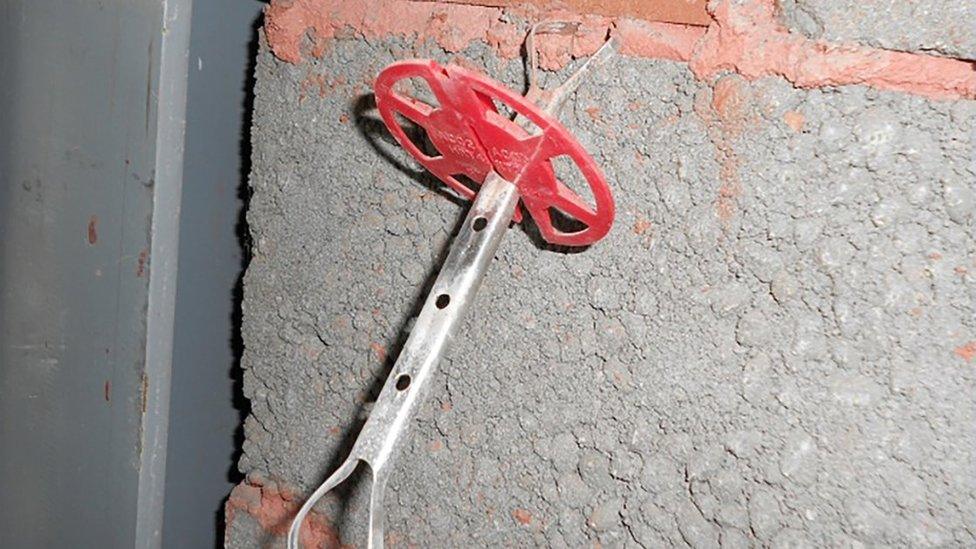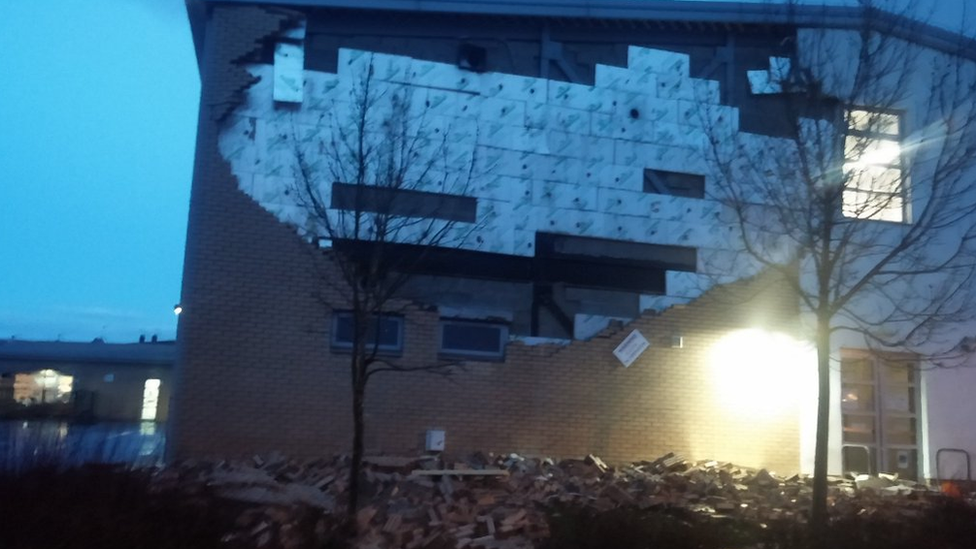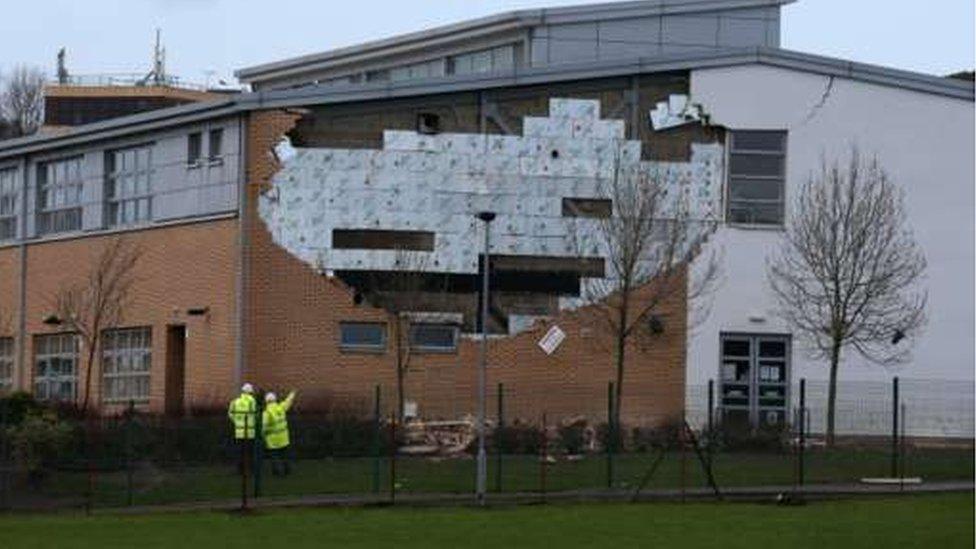Defects found at 72 more Scottish school buildings
- Published
- comments
A wall collapsed at Oxgangs Primary School in Edinburgh during stormy weather in January 2016
At least 72 more schools in Scotland were found to have similar defects to Edinburgh schools judged to be unsafe, a BBC investigation has found.
Concerns were raised after 17 schools in the capital were shut following a wall collapse at Oxgangs Primary in January last year.
Since then defects have been found at dozens of schools in 15 council areas.
While most of the buildings have now been repaired, work on six of them is still to be completed.
And fears have been voiced that there could be similar problems at other buildings constructed under public-private partnership (PPP) schemes like hospitals and care homes.
Problems first came to light when hundreds of bricks weighing a total of nine tonnes were blown from a wall at Oxgangs Primary School in Edinburgh during Storm Gertrude.
Ten primaries, five secondaries and two additional support needs schools - all built or refurbished as part of the same PPP scheme - were subsequently shut due to concerns over the standard of construction, affecting about 7,600 pupils.
A report into the Oxgangs collapse and wider Edinburgh issues identified problems with wall and header ties, which are used to hold exterior and interior walls together and attach them to the rest of the building.
BBC Scotland asked all of the country's local authorities if repair work involving wall ties or "significant structural issues" had been done at PPP schools, or others built under schemes such as non-profit distributing (NPD) or "design and build", in the past 18 months.
Relevant work was done at 72 schools in 15 local authority areas.
Adding in the 17 schools in Edinburgh, this totals 88 schools across Scotland - although 13 councils said they had not done intrusive surveys of the kind the Edinburgh schools report, external said was necessary to uncover problems.
And the figure may rise regardless, as Edinburgh City Council is still carrying out an estate-wide review and Highland Council did not respond to freedom of information requests.

Wall ties were identified as an issue in the Edinburgh inquiry, and have been checked at many other Scottish schools
Glasgow was the area where the most work had to be done, with 23 schools affected, including 22 built through PPP programmes and one under design-and-build. A council spokesman said all the schools surveyed were safe to occupy and the additional remedial work was carried out as a "precautionary measure".
Elsewhere, there were five in Aberdeenshire, four in Angus, five in Argyll and Bute, three in Dundee, four in East Lothian, two in Fife, three in Inverclyde, one in North Lanarkshire, 10 in South Lanarkshire, three in Stirling and three in West Lothian.
Clackmannanshire Council said it had carried repairs on two schools, but added that these were different to the structural defects identified in the Edinburgh schools.
'Frightening'
Prof Alan Dunlop, a fellow of the Royal Incorporation of Architects in Scotland and a visiting professor at Robert Gordon University, said the potential scale of the issue was "frightening".
He said: "The PPP financing process was not only used for schools, it was also used for hospitals and a number of public buildings, care homes, things like that. I'm wondering, if they found a similar problem in schools, are other things happening in other building type that have been used and building under PPP?
"And this is focusing primarily on wall ties and header ties - are there other elements of the building's structure that are actually at fault? I find it difficult to believe it could only rest with wall ties and header ties.
"We have to review and re-think how we build these buildings, especially for our children.
"The only way we found out about Oxgangs was because the wall collapsed. If the wall hasn't collapsed, we would never have been any the wiser - so we need intrusive surveys to find out just what on earth is going on."

Prof Alan Dunlop said the issue was "frightening", while Ian Honeyman said there were "big implications" for builders
Ian Honeyman from the Scottish Building Federation agreed that there were "big implications" for the building industry.
He said: "The fundamental point that has to be addressed is that people have to have confidence in the buildings that are being produced, and also be confident that people are safe when they're living or working in them.
"I don't think it's something that can be tackled by one individual company or one individual organisation - I think it has to be done by a combination of all organisations and people involved in the construction industry to look at the fundamental things that have gone wrong here, and look at how we can address it as an industry rather than as individuals."

Inspections were carried out at all the Edinburgh PPP schools
Mr Honeyman said the way work was signed off might need to be looked at.
He said: "The system itself in terms of the certification process requires ultimately one person to sign off a piece of paper called a completion certificate.
"Unfortunately there's not one person involved in the whole project who is actually in a position that can do that, because it's a combination of everybody - not one person can be on the site 24/7, see every piece of brick or steel or whatever else is put up, you can only be there so often.
"There are systems in place that are supposed to pick up these issues going through - but that relies on everyone in the chain to do what's expected of them. And when things get missed, that can have an impact further down the chain, and ultimately I think that's part of what's happened here.
"I think the whole industry has to look at the system and manage the system better than we have, as it's indicated at the moment."
'Customise schools'
Scotland's Education Secretary John Swinney told the Good Morning Scotland programme that since the establishment of the Scottish Futures Trust in 2007, the construction methods used to build schools had changed and that no school built since then had suffered the defects associated with the previous system.
He said: "These schools were built under a brick and block system. We now use a steel framing system, which is much more individually configured to individual schools and the Edinburgh example - where 17 schools were taken forward as a batch purchase by the City of Edinburgh Council - that no longer happens.
"We now do individual design, based on the steel framing system, to customise schools for the needs of individual localities and to give us much greater control over that construction process."
Mr Swinney acknowledged that ministers were unaware how many schools in total were affected by the issues that shut Oxgangs, adding that the responsibility lay with local councils.
He added: "Local authorities must be able to undertake the necessary technical changes and technical certification that is their statutory legal obligation to undertake and that's what I look to local authorities to undertake on behalf of parents the length and breadth of the country."
The Scottish Futures Trust is the arms-length company set up by the Scottish government to "deliver value for money across public sector infrastructure investment" and oversee contracts like PPP and NPD.
It wrote to local authorities and public bodies highlighting the Edinburgh inquiry report so each council could review its approach. The trust also noted the inquiry's recommendation that intrusive surveys were "the most reliable way of identifying similar issues which are not always clear from visual inspection alone".
A spokesman said: "We are now engaged as part of the Construction Procurement Review Team with Scottish government considering the recommendations of the report, in particular as they relate to procurement, supervision of construction and retention of as-built information with a view to producing updated guidance where considered necessary to reinforce the lessons which all engaged in the industry should take from the inquiry report."
- Published9 February 2017

- Published17 August 2016

- Published11 April 2016
